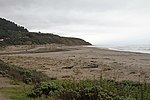Año Nuevo State Park

Año Nuevo State Park is a state park of California, United States, encompassing Año Nuevo Island and Año Nuevo Point, which are known for their pinniped rookeries. Located in San Mateo County, the low, rocky, windswept point juts out into the Pacific Ocean about 55 miles (89 km) south of San Francisco and the Golden Gate. Año Nuevo State Natural Reserve, formerly a separate unit of the California state park system, was merged into Año Nuevo State Park in October 2008. The coastal geographic center, or coastal-midpoint of California is located at the Northern end of this park at N 37°09′58″, W 122°21'40", as the absolute geographic center of California falls at N 37°09′58″, W 119°26′58″W.The reserve contains a diversity of plant communities, including old growth forest, freshwater marsh, red alder riparian forest and knobcone pine forest. Its four perennial streams support steelhead and coho salmon, and its wetlands are habitat to the rare San Francisco garter snake and California red-legged frog. Cultural resources include the remnants of a prehistoric Native American village site and a number of structures from the 19th century Cascade Ranch. In conjunction with adjacent and nearby public lands, the unit permits the protection of important regional ecological corridors. The point remains undeveloped, much as Sebastián Vizcaíno saw it from his passing ship in 1603.
Excerpt from the Wikipedia article Año Nuevo State Park (License: CC BY-SA 3.0, Authors, Images).Año Nuevo State Park
Geographical coordinates (GPS) Address Nearby Places Show on map
Geographical coordinates (GPS)
| Latitude | Longitude |
|---|---|
| N 37.133055555556 ° | E -122.33305555556 ° |
Address
San Mateo County (San Mateo)
California, United States
Open on Google Maps








